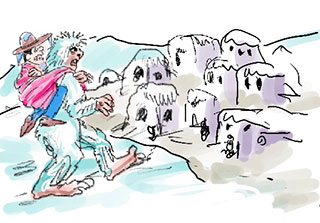What is the highest settlement in the world? Name the city which consumes the most Starbucks. These and more are in our latest travel trivia game.
Global Trivia 8
You have multiple choices. An explanation and a reference comes after every question. There is no fixed order so you can choose from any of the boxes. The SHADED BOXES are what you already answered. Your final score is at the END. Don't hit REFRESH unless you want to start all over. This is part of a continuing series in Traveling Boy.
Start
Congratulations!
You have completed Global Trivia 8.

You scored %%SCORE%% out of a possible 5 points.
Your performance was: %%RATING%%
Your answers are highlighted below.
Question 1 |

Name the highest human settlement in the world.
A | Dolpa – Karnali Zone, Nepal |
B | Parinacota – Arica-Parinacota, Chile |
C | La Rinconada – Puno, Peru |
D | Barrow – Alaska, US |
E | Wenquan - Qinghai, China |
Question 1 :
C. La Rinconada – Puno, Peru
1. La Rinconada, Peru — 16,732 feet: The highest permanently inhabited settlement in the world, is home to some of the most brutal living conditions known to man. About 50,000 people live in the settlement, perched atop Mount Ananea in the Peruvian Andes. It spends much of the year in sub-zero temperatures. The settlement lies in the shadow of Bella Durmiente — or Sleeping Beauty — an enormous glacier that lurks over the town, which has no hotels or hospitals, and the government has little to no presence in the town. What brought the majority of individuals this high up the mountain is a nearby gold mine. Here, men (women are not allowed in the mines) work for 30 days without salary. On the 31st day, they fill bags with as much earth and rock as they can carry and proceed to sift through the materials looking for gold. They keep what they can find and, if there is no gold, they earn nothing for the month. Women are permitted to work in the dump sites where earth movers discard extra earth and rock from the mining site. They sift through what has been dumped looking for gold. After such hard work, women and men go home to houses without plumbing.

2. Wenquan, China — 15,980 feet: The small city of Wenquan in Qinghai, China is located north of the Tanggula mountains in the Qinghai-Tibet Plateau. The few tourists who have visited here claim it is not much of a town. The Tanggula Pass is nearby which is the route to reach the Tibet Autonomous Area.
3. Korzok, India — 15,000 feet: Korzok, in Ladakh, Jammu, and Kashmir, India is home to Changpa nomads. The major economic activity is herding sheep that produce pashmina wool. This wool has increased in value over the last few years which has significantly boosted the economy. Agriculture, mainly barley and oats, also plays a big role in daily life of the residents. Horses plow the crops. Of note is the Korzok monastery located nearby which is around 500 years old.
4. Parinacota, Chile — 14,435 feet: Located in the Arica-Parinacota region of Chile, the town of 29 inhabitants is surrounded by the Lauca National Park. There is a small, 17th Century church here with watercolor painted murals.
5. Other Towns and Cities in the Sky: Other high altitude settlements above 14,000 feet are Dolpa in the Karnali Zone of Nepal (14,301 feet) and Mina Pirquitas in the Jujuy Province of Argentina (14,240 feet). After these communities, those still located in the greater than 13,000-foot altitude range are Colquechaca in the Potosi Department of Bolivia (13680 feet), Qarabolaq in the Wakhan District of Afghanistan (13,579 feet), and Chatyndy in the Ohh Province of Kyrgyzstan (13,166 feet). Finally, the last place on this list of high settlements is Laya in the Gasa District of Bhutan at 12,533 feet above sea level.
— World Atlas
1. La Rinconada, Peru — 16,732 feet: The highest permanently inhabited settlement in the world, is home to some of the most brutal living conditions known to man. About 50,000 people live in the settlement, perched atop Mount Ananea in the Peruvian Andes. It spends much of the year in sub-zero temperatures. The settlement lies in the shadow of Bella Durmiente — or Sleeping Beauty — an enormous glacier that lurks over the town, which has no hotels or hospitals, and the government has little to no presence in the town. What brought the majority of individuals this high up the mountain is a nearby gold mine. Here, men (women are not allowed in the mines) work for 30 days without salary. On the 31st day, they fill bags with as much earth and rock as they can carry and proceed to sift through the materials looking for gold. They keep what they can find and, if there is no gold, they earn nothing for the month. Women are permitted to work in the dump sites where earth movers discard extra earth and rock from the mining site. They sift through what has been dumped looking for gold. After such hard work, women and men go home to houses without plumbing.

2. Wenquan, China — 15,980 feet: The small city of Wenquan in Qinghai, China is located north of the Tanggula mountains in the Qinghai-Tibet Plateau. The few tourists who have visited here claim it is not much of a town. The Tanggula Pass is nearby which is the route to reach the Tibet Autonomous Area.
3. Korzok, India — 15,000 feet: Korzok, in Ladakh, Jammu, and Kashmir, India is home to Changpa nomads. The major economic activity is herding sheep that produce pashmina wool. This wool has increased in value over the last few years which has significantly boosted the economy. Agriculture, mainly barley and oats, also plays a big role in daily life of the residents. Horses plow the crops. Of note is the Korzok monastery located nearby which is around 500 years old.
4. Parinacota, Chile — 14,435 feet: Located in the Arica-Parinacota region of Chile, the town of 29 inhabitants is surrounded by the Lauca National Park. There is a small, 17th Century church here with watercolor painted murals.
5. Other Towns and Cities in the Sky: Other high altitude settlements above 14,000 feet are Dolpa in the Karnali Zone of Nepal (14,301 feet) and Mina Pirquitas in the Jujuy Province of Argentina (14,240 feet). After these communities, those still located in the greater than 13,000-foot altitude range are Colquechaca in the Potosi Department of Bolivia (13680 feet), Qarabolaq in the Wakhan District of Afghanistan (13,579 feet), and Chatyndy in the Ohh Province of Kyrgyzstan (13,166 feet). Finally, the last place on this list of high settlements is Laya in the Gasa District of Bhutan at 12,533 feet above sea level.
— World Atlas
Question 2 |

Name the city with the most Starbucks.
A | Seattle, WA |
B | Seoul, Korea |
C | Toronto, ONT |
D | Vancouver, BC |
E | New York City, NY |
Question 2 :
B. Seoul, Korea
Although Starbucks Corporation was founded in the US, only three of its cities rank among the top ten cities with the most Starbucks. Seattle, the founding place of Starbucks has 142 stores, ranking it in position eighth. New York City has the highest number of stores in the US (277), only second to Seoul that has 284 stores. The prominence of coffee shops in Seoul does not come as much of a surprise, as coffee is a popular drink in Korean culture. Starbuck Coffee Korea Corporation which operates the Starbuck stores in Seoul is a joint venture between Starbucks Corporation and Shinsegae.
Although Starbucks Corporation was founded in the US, only three of its cities rank among the top ten cities with the most Starbucks. Seattle, the founding place of Starbucks has 142 stores, ranking it in position eighth. New York City has the highest number of stores in the US (277), only second to Seoul that has 284 stores. The prominence of coffee shops in Seoul does not come as much of a surprise, as coffee is a popular drink in Korean culture. Starbuck Coffee Korea Corporation which operates the Starbuck stores in Seoul is a joint venture between Starbucks Corporation and Shinsegae.
Question 3 |
Who was the founder and original lead member of the Rolling Stones?
A | Mick Jagger |
B | Brian Jones |
C | Keith Richards |
D | Ian Stewart |
E | Charlie Watts |
F | Bill Wyman |
Question 3 :
B. Brian Jones

Lewis Brian Hopkins Jones (1942 – 1969) was an English musician, best known as the founder and original leader of the Rolling Stones. Initially a slide guitarist, Jones would go on to play a wide variety of instruments on Rolling Stones recordings and in concerts, such as rhythm and lead guitar, sitar, dulcimer, drums, various keyboard and wind instruments such as harmonica, recorder and saxophone.
Jones and fellow guitarist Keith Richards developed a unique style of guitar play that Richards refers to as the "ancient art of weaving" where both players would play rhythm and lead parts together (Richards would carry the style on with later Stones’ guitarist’s Ron Wood, but prior to that with the replacement of Jones, virtuoso Mick Taylor played lead guitar, and Richards would generally handle rhythm guitar.
After Jones founded the Rolling Stones as a British blues outfit in 1962, and gave the band its name, Jones' fellow band members Richards and Mick Jagger began to take over the band's musical direction, especially after they became a successful songwriting team. Jones also did not get along with the band's manager, Andrew Loog Oldham, who pushed the band into a musical direction at odds with Jones' blues background. At the same time, Jones developed alcohol and drug problems, and his performance in the studio became increasingly unreliable, leading to a diminished role within the band he had founded. In June 1969, the Rolling Stones asked Jones to leave the band, and he died less than a month later, drowning in the swimming pool at his home. The final event it is still clouded in mystery.
Long-time Rolling Stones bass guitarist Bill Wyman said of Jones, "He formed the band. He chose the members. He named the band. He chose the music we played. He got us gigs. ... he was very influential, very important, and then slowly lost it – highly intelligent – and just kind of wasted it and blew it all away."
Ian Andrew Robert Stewart (July 1938 – December 1985) was a Scottish keyboardist and co-founder of the Rolling Stones. He was removed from the line-up in May 1963 by manager Andrew Loog Oldham who felt that the older, burly, and square-jawed Stewart did not fit the band's image. He said Stewart could stay as road manager and play piano on recordings. Stewart accepted this demotion. Richards said: "[Stu] might have realized that in the way we were going to be marketed, he would be out of sync, but that he could still be a vital part. I'd probably have said, 'Well, fuck you', but he said 'OK, I'll just drive you around.' That takes a big heart, but Stu had one of the largest hearts around."
Stewart loaded gear into his van, drove the group to gigs, replaced guitar strings and set up Watts' drums the way he himself would play them. "I never ever swore at him," Watts says, with rueful amazement. He also played piano and occasionally organ on most of the band's albums in the first decades, as well as providing criticism. Shortly after Stewart's death Mick Jagger said: "He really helped this band swing, on numbers like 'Honky Tonk Women' and loads of others. Stu was the one guy we tried to please. We wanted his approval when we were writing or rehearsing a song. We'd want him to like it.” Ian Stewart was posthumously inducted into the Rock and Roll Hall of Fame along with the rest of the band in 1989.

Lewis Brian Hopkins Jones (1942 – 1969) was an English musician, best known as the founder and original leader of the Rolling Stones. Initially a slide guitarist, Jones would go on to play a wide variety of instruments on Rolling Stones recordings and in concerts, such as rhythm and lead guitar, sitar, dulcimer, drums, various keyboard and wind instruments such as harmonica, recorder and saxophone.
Jones and fellow guitarist Keith Richards developed a unique style of guitar play that Richards refers to as the "ancient art of weaving" where both players would play rhythm and lead parts together (Richards would carry the style on with later Stones’ guitarist’s Ron Wood, but prior to that with the replacement of Jones, virtuoso Mick Taylor played lead guitar, and Richards would generally handle rhythm guitar.
After Jones founded the Rolling Stones as a British blues outfit in 1962, and gave the band its name, Jones' fellow band members Richards and Mick Jagger began to take over the band's musical direction, especially after they became a successful songwriting team. Jones also did not get along with the band's manager, Andrew Loog Oldham, who pushed the band into a musical direction at odds with Jones' blues background. At the same time, Jones developed alcohol and drug problems, and his performance in the studio became increasingly unreliable, leading to a diminished role within the band he had founded. In June 1969, the Rolling Stones asked Jones to leave the band, and he died less than a month later, drowning in the swimming pool at his home. The final event it is still clouded in mystery.
Long-time Rolling Stones bass guitarist Bill Wyman said of Jones, "He formed the band. He chose the members. He named the band. He chose the music we played. He got us gigs. ... he was very influential, very important, and then slowly lost it – highly intelligent – and just kind of wasted it and blew it all away."
Ian Andrew Robert Stewart (July 1938 – December 1985) was a Scottish keyboardist and co-founder of the Rolling Stones. He was removed from the line-up in May 1963 by manager Andrew Loog Oldham who felt that the older, burly, and square-jawed Stewart did not fit the band's image. He said Stewart could stay as road manager and play piano on recordings. Stewart accepted this demotion. Richards said: "[Stu] might have realized that in the way we were going to be marketed, he would be out of sync, but that he could still be a vital part. I'd probably have said, 'Well, fuck you', but he said 'OK, I'll just drive you around.' That takes a big heart, but Stu had one of the largest hearts around."
Stewart loaded gear into his van, drove the group to gigs, replaced guitar strings and set up Watts' drums the way he himself would play them. "I never ever swore at him," Watts says, with rueful amazement. He also played piano and occasionally organ on most of the band's albums in the first decades, as well as providing criticism. Shortly after Stewart's death Mick Jagger said: "He really helped this band swing, on numbers like 'Honky Tonk Women' and loads of others. Stu was the one guy we tried to please. We wanted his approval when we were writing or rehearsing a song. We'd want him to like it.” Ian Stewart was posthumously inducted into the Rock and Roll Hall of Fame along with the rest of the band in 1989.
Question 4 |
Name the mountain, body of water or settlement NOT named by British captain, explorer and navigator George Vancouver.
A | Mount Baker |
B | Mount St. Helens |
C | Puget Sound |
D | Mount Rainier |
E | Vancouver, BC |
Question 4 :
E. Vancouver, BC
Vancouver was originally a small saw milling settlement, called Granville in the 1870s. It was incorporated as a city in April 1886 (just before it became the western terminus of the first trans-Canada railway and was renamed Vancouver by Pacific Railway president, William Van Horne in honor the British captain, explorer and navigator George Vancouver.
Also named in honor of Captain George Vancouver: Vancouver Island, Vancouver, Washington. Mount Vancouver of Yukon and Alaska (on the Canadian-American border) and New Zealand's sixth highest mountain.
Captain Vancouver named the following:
Vancouver was originally a small saw milling settlement, called Granville in the 1870s. It was incorporated as a city in April 1886 (just before it became the western terminus of the first trans-Canada railway and was renamed Vancouver by Pacific Railway president, William Van Horne in honor the British captain, explorer and navigator George Vancouver.
Also named in honor of Captain George Vancouver: Vancouver Island, Vancouver, Washington. Mount Vancouver of Yukon and Alaska (on the Canadian-American border) and New Zealand's sixth highest mountain.
Captain Vancouver named the following:
- Mount Baker – after Discovery's 3rd Lieutenant Joseph Baker, the first on the expedition to spot it
- Mount St. Helens – after his friend, Alleyne Fitzherbert, 1st Baron St Helens
- Puget Sound – after Discovery's 2nd lieutenant Peter Puget, who explored its southern reaches.
- Mount Rainier – after his friend, Rear Admiral Peter Rainier.
Question 5 |
When Spanish General Franco was on his deathbed in 1975, supporters congregated outside and chanted: “Farewell General!” What did Franco say to his nurse?
A | Are they going somewhere? |
B | God demands that I live for the Spanish people forever. |
C | Those heathen bastards were lucky to have me. |
D | Soon we will all bask in the presence of the Lord and his angels. |
E | The people are barbarians, but made good Catholics. |
Question 5 :
A. Are they going somewhere?
Francisco Franco Bahamonde (1892 – 1975) was a Spanish general and politician who ruled over Spain as head of state and dictator under the title Caudillo from 1939, after the Nationalist victory in the Spanish Civil War, until his death in 1975. This period in Spanish history is commonly known as Francoist Spain or the Francoist dictatorship.
Born in Ferrol, Spain, the son of upper-class parents with strong connections to the Spanish Navy, Franco however joined the Spanish Army as a cadet in the Toledo Infantry Academy in 1907, graduating in 1910. He would go on to have a successful military career in Morocco and advanced through the ranks at a very young age. As a conservative and a monarchist, Franco opposed the leftist Popular Front which had won the 1936 elections. Franco joined other Generals who launched a coup the same year, intending to overthrow the republic. The coup failed to take control of most of the country and precipitated the Spanish Civil War. The left side, known as the Republicans, consisted of the Spanish government together with unions, communists, anarchists, workers, peasants, international brigades – including Ernest Hemingway and George Orwell – and support of the Soviet Union. On the other side were the Nationalists, the rebel part of the army, the bourgeoisie, the landlords, the upper classes along with Nazi Germany and Fascist Italy. The war played out the in the international press as battle between freedom and autocratic rule. Important writings include Hemingway’s ‘For Whom the Bell Tolls’ and Orwell’s ‘Homage to Catalonia.’
In 1939 Franco won the war, which had claimed almost half a million lives. The victory extended his dictatorship to the whole country and was followed by a period of repression of political opponents and dissenters, with the result that between 30,000 and 50,000 died through the use of forced labor and executions in concentration camps. Combined with the Nationalist executions during the war, the death toll of the White Terror lies at around 100,000 and 200,000.
Franco continued to rule Spain alone, with more power than any Spanish leader before or since, ruling almost exclusively by decree. He nurtured a cult of personality and the Movimiento Nacional became the only channel of participation in Spanish public life. Franco remains a controversial figure in Spanish history and the nature of his dictatorship changed over time. His reign was marked by both brutal repression, with thousands killed, and economic prosperity, which greatly improved the quality of life in Spain. His dictatorial style proved very adaptable, which could introduce social and economic reform, and the only consistent points in Franco's long rule were above all authoritarianism, Spanish nationalism, national Catholicism, anti-Freemasonry, and anti-communism.
Francisco Franco Bahamonde (1892 – 1975) was a Spanish general and politician who ruled over Spain as head of state and dictator under the title Caudillo from 1939, after the Nationalist victory in the Spanish Civil War, until his death in 1975. This period in Spanish history is commonly known as Francoist Spain or the Francoist dictatorship.
Born in Ferrol, Spain, the son of upper-class parents with strong connections to the Spanish Navy, Franco however joined the Spanish Army as a cadet in the Toledo Infantry Academy in 1907, graduating in 1910. He would go on to have a successful military career in Morocco and advanced through the ranks at a very young age. As a conservative and a monarchist, Franco opposed the leftist Popular Front which had won the 1936 elections. Franco joined other Generals who launched a coup the same year, intending to overthrow the republic. The coup failed to take control of most of the country and precipitated the Spanish Civil War. The left side, known as the Republicans, consisted of the Spanish government together with unions, communists, anarchists, workers, peasants, international brigades – including Ernest Hemingway and George Orwell – and support of the Soviet Union. On the other side were the Nationalists, the rebel part of the army, the bourgeoisie, the landlords, the upper classes along with Nazi Germany and Fascist Italy. The war played out the in the international press as battle between freedom and autocratic rule. Important writings include Hemingway’s ‘For Whom the Bell Tolls’ and Orwell’s ‘Homage to Catalonia.’
In 1939 Franco won the war, which had claimed almost half a million lives. The victory extended his dictatorship to the whole country and was followed by a period of repression of political opponents and dissenters, with the result that between 30,000 and 50,000 died through the use of forced labor and executions in concentration camps. Combined with the Nationalist executions during the war, the death toll of the White Terror lies at around 100,000 and 200,000.
Franco continued to rule Spain alone, with more power than any Spanish leader before or since, ruling almost exclusively by decree. He nurtured a cult of personality and the Movimiento Nacional became the only channel of participation in Spanish public life. Franco remains a controversial figure in Spanish history and the nature of his dictatorship changed over time. His reign was marked by both brutal repression, with thousands killed, and economic prosperity, which greatly improved the quality of life in Spain. His dictatorial style proved very adaptable, which could introduce social and economic reform, and the only consistent points in Franco's long rule were above all authoritarianism, Spanish nationalism, national Catholicism, anti-Freemasonry, and anti-communism.
Once you are finished, click the button below. Any items you have not completed will be marked incorrect.
Get Results
There are 5 questions to complete.
You have completed
questions
question
Your score is
Correct
Wrong
Partial-Credit
You have not finished your quiz. If you leave this page, your progress will be lost.
Correct Answer
You Selected
Not Attempted
Final Score on Quiz
Attempted Questions Correct
Attempted Questions Wrong
Questions Not Attempted
Total Questions on Quiz
Question Details
Results
Date
Score
Hint
Time allowed
minutes
seconds
Time used
Answer Choice(s) Selected
Question Text
All done
Deplorable! You need to travel more! This is pathetic!
Deplorable! You need to travel more! This is pathetic!
Embarrassing! Keep trying! We know you're better than that. Play the game again.
Not that bad! But not good either. Play the game again.
Pretty good ... but not perfect.
Perfect! Are you brilliant traveler or what?

